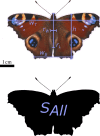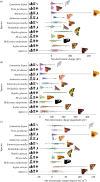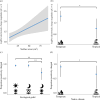Electrostatic pollination by butterflies and moths
- PMID: 39044626
- PMCID: PMC11267234
- DOI: 10.1098/rsif.2024.0156
Electrostatic pollination by butterflies and moths
Abstract
Animals, most notably insects, generally seem to accumulate electrostatic charge in nature. These electrostatic charges will exert forces on other charges in these animals' environments and therefore have the potential to attract or repel other objects, for example, pollen from flowers. Here, we show that butterflies and moths (Lepidoptera) accumulate electrostatic charge while in flight. Then, using finite element analysis, we demonstrate that when within millimetres of a flower, the electrostatic charge of a lepidopteran generates an electric field in excess of 5 kV m-1, and that an electric field of this magnitude is sufficient to elicit contactless pollen transfer from flowers across air gaps onto the body of a butterfly or moth. Furthermore, we see that phylogenetic variations exist in the magnitude and polarity of net charge between different species and families and Lepidoptera. These phylogenetic variations in electrostatic charging correlate with morphological, biogeographical and ecological differences between different clades. Such correlations with biogeographical and ecological differences may reflect evolutionary adaptations towards maximizing or minimizing charge accumulation, in relation to pollination, predation and parasitism, and thus we introduce the idea that electrostatic charging may be a trait upon which evolution can act.
Keywords: Lepidoptera; electric fields; flowers; insects; pollen; static charge.
Conflict of interest statement
We declare we have no competing interests.
Figures






References
-
- Edwards DK. 1960. A method for continuous determination of displacement activity in a group of flying insects. Can. J. Zool. 38 , 1021–1025. (10.1139/z60-105) - DOI
-
- Edwards DK. 1962. Laboratory determinations of the daily flight times of separate sexes of some moths in naturally changing light. Can. J. Zool. 40 , 511–530. (10.1139/z62-044) - DOI
-
- Erickson EH. 1975. Surface electric potentials on worker honeybees leaving and entering the hive. J. Apic. Res. 14 , 141–147. (10.1080/00218839.1975.11099818) - DOI
-
- Gan-Mor S, Schwartz Y, Bechar A, Eisikowitch D, Manor G. 1995. Relevance of electrostatic forces in natural and artificial pollination. Can. Agric. Eng. 37 , 189–194.
MeSH terms
Grants and funding
LinkOut - more resources
Full Text Sources
